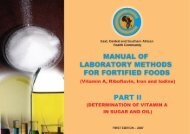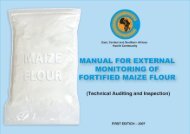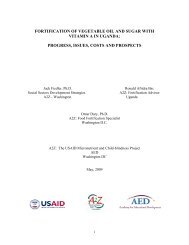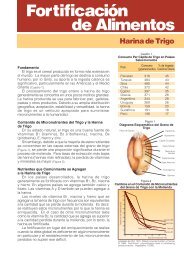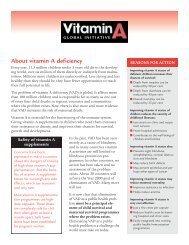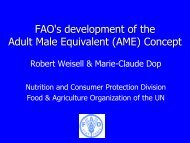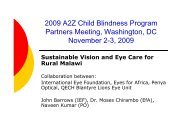manual of methods for determining micronutrients in fortified foods
manual of methods for determining micronutrients in fortified foods
manual of methods for determining micronutrients in fortified foods
Create successful ePaper yourself
Turn your PDF publications into a flip-book with our unique Google optimized e-Paper software.
7. Transfer the extract to a 250 mL volumetric flask and br<strong>in</strong>g to volume with water.<br />
8. Filter the cold solution through Whatman paper No. 2V, try to filter only the supernatant. Centrifug<strong>in</strong>g<br />
the solution will help to obta<strong>in</strong> a clear filtrate.<br />
9. Transfer 100 mL <strong>of</strong> the filtrate, measured with a volumetric pipette, to 250 mL Erlenmeyer flask<br />
conta<strong>in</strong><strong>in</strong>g 300 mg oxalic acid.<br />
10. Mix well and adjust f<strong>in</strong>al pH to 6.5 to 7.0 by dropwise addition <strong>of</strong> filtrate or by addition <strong>of</strong> a few<br />
crystals <strong>of</strong> oxalic acid.<br />
11. Centrifuge the filtrate at 5,000 rpm <strong>for</strong> 10 m<strong>in</strong>utes. Filter slowly through 1 or 2 pieces <strong>of</strong> Whatman<br />
No. 42 paper so that clear filtrate is obta<strong>in</strong>ed.<br />
12. Condition C18 cleanup cartridge with 10 mL ethanol and then pass 10 mL water.<br />
13. Slowly pass 10 mL clear sample filtrate through cartridge.<br />
14. Discard first 6 mL and collect next 3.5 mL <strong>in</strong> sample vial.<br />
15. Add 1 drop 85% fos<strong>for</strong>ic acid (H 3<br />
PO 4<br />
) and mix well.<br />
16. Inject 100 µL standard and sample solutions us<strong>in</strong>g the chromatographic conditions described below.<br />
Parameter<br />
Condition<br />
Column<br />
C18. Waters. 250 mm x 4.1mm ID<br />
Flow<br />
1.5 mL/m<strong>in</strong><br />
Detector<br />
Ultraviolet<br />
Wavelength: 254 nm<br />
Injection volume 100 µL<br />
Note: The peak shape and retention time may be modified by add<strong>in</strong>g acetonitrile (95% mobile phase: 5% acetonitrile).<br />
VII.<br />
Calculations<br />
1. Calculate the equation <strong>of</strong> the standard curve us<strong>in</strong>g height (y) vs. concentration-mg/L (x) <strong>for</strong> the<br />
three standard concentrations <strong>in</strong>jected.<br />
2. The correlation coefficient (r) should be 0.999 or above.<br />
3. Calculate the niac<strong>in</strong> concentration (mg/L) <strong>in</strong> the <strong>in</strong>jected solution us<strong>in</strong>g the regression equation.<br />
4. Us<strong>in</strong>g the concentration <strong>of</strong> sample <strong>in</strong> mg/L, calculate niac<strong>in</strong> concentration <strong>in</strong> the sample us<strong>in</strong>g<br />
the follow<strong>in</strong>g equation.<br />
Where:<br />
Parameter Explanation Value<br />
C s<br />
Concentration <strong>of</strong> niac<strong>in</strong> <strong>in</strong> the sample (mg/L) obta<strong>in</strong>ed from the regression<br />
equation.<br />
?<br />
V i<br />
Initial volume (mL) 250<br />
W s<br />
Sample weight (g). Around 2 g. ?<br />
- 49 -






